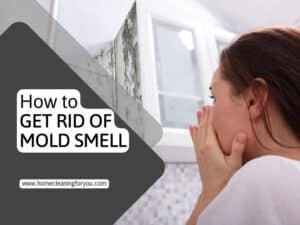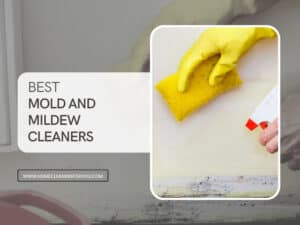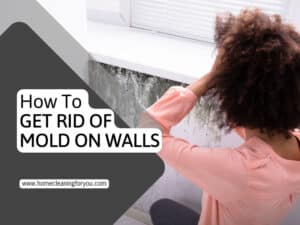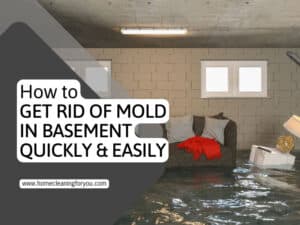How To Easily Remove Stubborn Mold From Wood
How to remove mold from wood, you ask? Mold is a common issue in many households, especially during summer where the humidity reaches its peak. It’s everywhere, invading your wood wardrobe, garden furniture, and flooring structures.
Apart from ruining the beauty of wood, mold is a threat to your health. That said, you may want to say goodbye to it as quickly as possible. With the help of this post, the process is as easy as a walk in the park.
Now, let’s gear up and get down to business!

Briefly Speaking, How Do You Remove Mold From Wood?
Mold can be wiped off wood surfaces easily so long as it is still in the inaugural state. To do this, just follow the instructions provided below:
- Wear protective clothing and equipment
- Vacuum the mold spores
- Clean the wood surface with homemade remedies (water mixed with dishwashing soap, white distilled vinegar, or borax)
- Sand the area to eliminate stubborn mold
To begin with, I’ll go through some quick facts about mold, your wood furniture’s implacable enemy. Let’s go!
Some Facts About Mold And How It Attack Your Wood
Besides food, mold is also not welcome on your wood furniture and flooring. Not only does it ruin your house’s curb appeal, but it also puts your health at risk, like headache, fatigue, or respiratory infections.
That said, if you notice fuzzy on any wooden surface, you’d better act quickly. You are most likely to see it appear in the kitchen, bathroom, or any space with poor insulation or affected by water seepage. Mold can also develop outdoors, such as on the balcony or bench.
Different Types Of Mold Growing On Wood
Wood-decay mold can be categorized into three different kinds as per its color: green, white, and black. You can expect to see mold thrive around early spring or mid-fall. Nonetheless, the situation is the worst during summer, so you should be ready when the heatwave arrives.
White Mold
Strictly speaking, white mold is not a type of mold but refers to a stage of its development. At first, most molds are in white. After producing the spores and being pigmented, the color will change depending on external factors like heat, light, or even the material they grow on.
White mold is normally overlooked because it seems harmless or sometimes difficult to spot, especially on light wood. While it’s true that it is not too toxic compared to pigmented molds, you should still deal with it immediately before the damage is irreversible.

Green Mold
You will usually find green mold on bread or rice, but it can also appear on porous materials like wood. There are many varieties of green mold, but the most common are Cladosporium, Aspergillus, and Penicillium.
Similar to white mold, a dampened area is the conducive environment for green mold to nestle its colony. It is often thought of as non-toxic, but only when compared to black mold. Exposure to green mold will cause serious health problems for sensitive people and pets.

Black Mold
Initially discovered in Prague in 1837, black mold has since been regarded as a dire threat to human health because it contains mycotoxins. These toxins are reported to cause chronic fatigue, rashes, or even depression. (1)
Black mold receives its color thanks to melanin, which also plays a vital part in the existence of the mold colony. This species relies on excessive moisture, so you can expect to see it on surfaces affected by flood or leakage.
Unlike green and white molds, black mold removal requires more time and patience. Yet, it is still overall an easy job, so you should not be too worried.
In some cases, you will spot streaks of dark-colored mold on your walls or ceiling, but that is not black mold. It’s often referred to as “cosmetic” mold, which does no harm to your health as well as wood structures. Hence, no removal action is required. (2)

What Mold Do To Your Precious Wood Flooring And Furniture
Wood has a natural ability to absorb and retain water. Over time, with heat and mold spores, which are ubiquitous and can be spread easily through air or water, a fungus colony is born.
If left for a long time, the colony will expand and cause wooden structures to change their colors, or worse, be rotten and destroyed. Consequently, you have no other choice but to replace or dispose of the affected wood properly.
Therefore, you are well-advised to deal with the problem as quickly as possible, specifically when black mold is not visible. When your wooden furniture is speckled with only green or white mold, the issue is not severe and can be resolved with ease.
How To Remove Mold From Wood With Natural Remedies
Mold does not belong to your lovey-dovey home, but your wood furniture and floor do. That said, if you notice mold taking over any wood surface, you should immediately resolve the problem.
Before showing you the ultimate solution to kill mold, I will have to debunk a myth first. For some people, mold cannot grow in a dry and cold environment. This is not correct, as mold is, in truth, waiting for the perfect opportunity to thrive.
Hence, don’t hesitate to put the problem to bed. The more you wait, the worse the damage!
General Guide
This guide applies to most types of mold, whether it’s light or stubborn. Besides the cleaning tools, you will need some protective gear as mold is harmful to your health.
Tools And Supplies
- Protective air mask
- Safety goggles
- Gloves
- Vacuum with HEPA filter
- Soft brush
- Dishwashing soap
- Warm water
- Spray bottle
- 100-grit sandpaper
- Fan (optional)
Instructions
Step 1: Put on your protective gear. If you are sensitive or have a severe mold allergy, make sure that you are fully covered to reduce exposure. Wearing a long-sleeved shirt and pants is highly recommended.
Step 2: Run a vacuum with a HEPA filter over moldy areas to suck up loose mold spores. Next, transfer the mold from the container to a tightly sealed plastic bag before putting it in the trash can. Don’t forget to clean the vacuum container.
Step 3: Clean the mold using homemade solutions. There are various options you can try, but your best bet is a mixture of dishwashing soap and water.
- Add a teaspoon of dishwashing soap to warm water.
- Transfer the solution to a spray bottle.
- Spray the moldy areas generously. Then, use a soft-bristled brush and gently scrape off the mold.
If dishwashing soap failed to kill the mold spores, turn to white distilled vinegar, which carries antifungal properties.
- Add equal parts of white vinegar and water to a spray bottle.
- Spritz the solution on moldy spots.
- Let it sit for about an hour. Then, wipe off the solution with a dampened cloth before drying the surface using a clean towel.
Alternatively, use borax for a stronger effect. It is not as invasive as bleach, so you shouldn’t be worried that it will damage your wood surface.
- For every tablespoon of borax, dilute it with one cup of water. Next, apply the solution to the mold using a soft brush.
- Scrape the mold off gently. You don’t have to sponge up excess liquid, as the point is to let the wood take in as much of the solution as possible.
- Dry the entire surface using a dehumidifier. If you don’t have this equipment, you can use a high-speed fan, too.
Step 4: If mold has deeply penetrated the surface, sanding is your last resort. Use 100-grit paper and run it across the surface. Don’t apply too much pressure, or you will damage the area. After sanding, repeat step 2 to get rid of mold spores.
Keep mold away from your wood furniture with this easy guide:
In-Depth Guide
Don’t be disappointed if the previous method did not work, as there are more approaches for you to try. If you are dealing with light mold, sunlight or other cleaning solutions like vinegar should be effective. However, with more stubborn mold, you’ll have to turn to bleach.
Wooden Furniture
Moldy furniture deserves a chance to stay in your house. With these helpful options, you will bring back its glam in no time! Keep reading and find out how to remove mold from wooden furniture with no effort.

Option 1: Kill Light Mold With Ultraviolet (UV) Light From The Sun
This should be the very first method to fight mold because it does not cost you anything, plus does minimal damage to your wooden furniture. Ask someone in your family to move out the furniture pieces should they be too heavy to carry on one’s own.
Step 1: Put on protective gear, including an air mask, goggles, and gloves.
Step 2: Cover the furniture with a garbage bag so that the mold spores will not escape while you are moving it.
Step 3: Place the furniture facing direct sunlight. Before the sunset, bring it back inside. You can repeat this process for a few days until the mold evaporates.
Note: Check the weather report in advance before moving your furniture outside. You don’t want your wood cabinet or shelf to face a heavy rainfall or storm.
This method mostly works with light mold. Therefore, if you have more serious issues, move on to the second option: using homemade cleaners.
Option 2: Wipe Off The Mold With Homemade Cleaners
You have already known that dishwashing soap can clean mold, but what other viable option is available? Scroll down now!
- Dishwashing soap: You will use this as instructed in the general guide section.
- Distilled white vinegar: Fill a spray bottle with distilled white vinegar. Next, spray the furniture and leave it for an hour. Finally, wipe the surface with a clean cloth rag.
- Baking soda: Place baking soda directly on affected areas. For mold rooting deeper, mix baking soda with water in a spray bottle, then spray the surface twice. Likewise, wipe off the solution once the mold spores have disappeared.
- Vodka: Similarly, add vodka to a spray bottle (you don’t have to use expensive stuff). Spray the entire surface and wait about 10 minutes before scrubbing the mold with a clean sponge.
- Tea tree oil: Not many people know that tea tree oil is one of the natural fungicides. You will mix a teaspoon of tea tree oil with two cups of water in a spray bottle. Spray the area, let dry, and wipe off until clean.
- Borax: Mix one cup of borax with a gallon of water in a bucket. Dampen a clean cloth rag with the solution and gently wipe off the mold. Once the furniture is fully dry, wipe it with a clean cloth rag dampened with some drops of linseed oil.
Note: If you carry out the job inside, make sure that the space is well-ventilated so that it can dry out quicker.
Option 3: Resort To Bleach
Bleach is a harmful chemical cleaner, so it should be your very last option. A practical piece of advice is to wear old clothes while you are working with bleach. Once you are set, gather the following tools and supplies.
Tools And Supplies
- Protective air mask
- Safety goggles
- Gloves
- Bucket
- Bleach
- Dishwashing soap
- Water
- Scrub sponge or soft-bristled brush
- 120 or 220-grit sandpaper
Step 1: Again, don’t forget to put on your protective gear: air mask, goggles, and gloves.
Step 2: Create a bleach solution by mixing bleach (2 1/2 cups) with detergent (1/4 cup) and water (5 cups). Stir the solution.
Step 3: With a sponge or soft brush, apply the solution to the furniture. Use circular motions and apply gentle pressure to minimize damage.
Step 4: Mold rooted deeply under the surface will need to be sanded. Go for 120 or 220-grit sandpaper for this job to prevent damage. Still, your furniture will have to be refinished after the mold is removed.
Step 5: Finally, clean your furniture with the same solution and air dry it.
Note: You are well-advised to sand while your furniture is still dampened. This helps prevent spores from spreading.
Sanding is straightforward with these clear and in-depth instructions.
Indoor Wooden Structures
As mentioned previously, a house with ventilation or leakage problems are the culprit of toxic mold. From drywall, ceiling tiles to window sills, mold will grow by leaps and bounds provided that the conducive conditions are fulfilled.
Window Frame And Sill
Don’t pray that mold will give your windows a break. Over time, it will begin to climb over the walls and only God knows where it will stop. Given that, time is the essence to stop the mold expansion.
Tools And Supplies
- Protective air mask
- Safety goggles
- Gloves
- Spray bottle
- Dishwashing soap
- Bleach
- Water
- Sponge
Instructions
Step 1: Protect yourself from inhaling mold spores with an air mark, a pair of safety goggles and gloves.
Step 2: Mist the mold with plain water. Doing this will prevent the spores from releasing into the air.
Step 3: Apply a solution made from dishwashing soap and water to the moldy area using a sponge. Use pressure if needed.
Step 4: Moving on, you will combine half a cup of bleach with a gallon of water. Again, using the sponge to apply the solution to the affected part. Be careful not to drop the solution on the floor.
Step 5: After 15 minutes, rinse the bleach solution off with plain water.
Step 6: Allow the window to air dry.
Walls And Ceiling
Removing mold from wood furniture sounds relatively simple, but what should you do if mold is on wood floors and ceilings? Follow the instructions below and put this problem to bed right away!

Tools And Supplies
- Protective air mask
- Safety goggles
- Gloves
- Spray bottle
- Dishwashing soap
- Distilled white vinegar
- Water
- Cloth rag
- Ladder (optional)
- Hydrogen peroxide or any chemical solution (optional)
Instructions
Step 1: Firstly, you will have to determine the source of the mold. Check whether your house is experiencing any water leakage or issues relating to moisture.
Step 2: Remove the furniture that gets in the way before getting started.
Step 3: Add dishwashing soap, vinegar, and water to a spray bottle. Spray the area entirely and let the solution sit for approximately 10 minutes. If the mold is on the ceiling, you will need to use a ladder.
Step 4: Once completely dry, wipe the solution with a clean cloth rag. Provided the mold still refuses to come off, seek help from hydrogen peroxide or any chemical cleaner.
Step 5: With another cloth rag, clean the surface properly before putting the pieces back to their original place. Your cleaning work is done!
Unfinished Wood Panelling
If your house is under construction and unfortunately, a heavy flood strikes the area, your wood panels are likely to be impacted. With a constant air flow, mold will soon grow and thrive rapidly. To deal with mold on untreated wood, assemble the following supplies.
Tools And Supplies
- Protective air mask
- Safety goggles
- Gloves
- Baking soda
- Ammonia
- White distilled vinegar
- Bucket
- Water
- Sponge
- Clean towel
- Fan (optional)
Instructions
Step 1: Like previous methods, the very first thing you must do is wear your gloves, goggles, and air mask.
Step 2: Mix the liquids in a bucket using this formula: a quarter cup of baking soda, a half cup of vinegar, and a cup of ammonia. Stir to dissolve.
Step 3: Dip the sponge into the solution. Then, begin scrubbing the surface to eliminate the spores.
Step 4: Rinse the area with clean water. To absorb the excess moisture, dry the panels with a clean towel. If you wish to facilitate the procedure, use a fan.
Outdoor Wooden Structures
You will experience problems with mold outside, too. Wooden fixtures like the deck, patio, or fences are moistened after heavy showers, causing the mold to spread like wildfire. So, what measures should be taken to address this problem?
Wood Deck And Patio
Although outdoor wooden structures, such as the deck, are exposed to sunlight, there’s still a high possibility of mold, especially during summer when the humidity is higher than in other seasons. Here are the steps of how to clean off mold on these surfaces.

Tools And Supplies
- Protective air mask
- Safety goggles
- Gloves
- Dishwashing soap
- Water
- Bucket
- Hard brush
- Cloth rag
- Specialized deck cleaner (optional)
Instructions
Step 1: First and foremost, don your protective equipment.
Step 2: Combine dishwashing soap and water in a bucket. Then, dampen a stiff brush and begin scrubbing the affected area.
Step 3: If the mold persists, move on to a specialized deck cleaner. After finishing the work, use a clean cloth rag to wipe the entire surface.
Wooden Fences
Wooden fences make your house look chic, but it becomes less chic once you begin to see tiny mold spores growing on them, particularly when you have light wood fences. Get it out of your sight with this simple cleaning trick.
Tools And Supplies
- Protective air mask
- Safety goggles
- Gloves
- Bleach or vinegar
- Water
- Sponge
- Garden hose
Step 1: It’s the same old rule: get your protective equipment ready before doing this job.
Step 2: Create a cleaning solution made of bleach and water (ratio 1:2). If you don’t want to work with bleach, opt for half a cup of vinegar per a gallon of water.
Step 3: Scrub the mold off using the solution and a sponge.
Step 4: Rinse the affected areas with your garden hose. Let the fences dry naturally.
Note: The solution can easily remove algae, too. What’s not to love?
Remove mold and algae from your wooden fences with this effective DIY solution.
Tips On Removing And Preventing Mold From Wood
Don’t skip these helpful tips. They will help you facilitate the mold removal process and allow your wood to maintain its curb appeal. Check them out!
- Determine the source: As mentioned, poor ventilation and moisture are what bring the mold to life. However, mold growing on wooden benches or decks is typically caused by trees, which are usually planted next to garden furniture for shade.
- Keep the surface dry: Moisture is the culprit of the problem, so make sure that your wood furniture or boarding is always dry.
- Reduce the humidity: If you live in an area with high humidity, you will want to invest in a dehumidifier to control the moisture level, preventing mold formation. If you often dry laundry inside, kick this habit as well.
- Refinish your furniture: Harsh chemical cleaners such as bleach or sanding will dent the finish of your furniture. Therefore, refinishing is needed if you want to bring back its former glory.
- Prevent future mold: To avoid mold from ambushing your furniture in the future, it is necessary to take precautions. Waterproofing, oil treatment, or anti-mold paint will be just the thing. Act now or regret it later!
- Replace wood if it’s beyond damage: Assuming that the problem has gone way out of control (mold has covered roughly 10 square feet of the area), it’s time you let your wood rest in peace.
Lastly, if you have mold allergies or any respiratory problems, do not attempt to finish this job by yourself. Instead, call in a professional mold cleaner to avoid putting your health at risk. If possible, you can start thinking about buying furniture made with other materials.
FAQs
If you are still perplexed with removing mold from wood at this point, check out the following section. I am sure that it will not take you more than five minutes!
Keep The Mold At Bay For Good
With this post, I hope you have succeeded at how to remove mold from wood and keep your furniture spotlessly clean. Mold is such a nuisance, so there’s no point compromising with it. Remove it as soon as you see the very first spores on the surface.
Enjoying my post so far? If so, don’t be shy to link it to your loved ones that are experiencing a rough time with mold. And, if you’d like to contribute any tips or tricks, just comment below, and I’ll be more than happy to read them. I wish you luck with the work!

References
- Medicalnewstoday.com. 2021. Black mold exposure: Symptoms, treatment, and prevention. [online] Available at: https://www.medicalnewstoday.com/articles/323419.
- Kootenay-home-inspector.ca. 2021. Kootenay Home and Property Inspection services – Nelson BC, Castlegar, Trail, GrandForks, Creston, Kaslo – West Kootenay Real Estate Professional Services – helping property guys and home buyers – Cosmetic Mold – an article from InspectAPedia.com. [online] Available at: https://www.kootenay-home-inspector.ca/cosmetic-mold.





Kevin Jones
Founder & Chief Home Organization Strategist
Expertise
Home Organization & Decluttering, Efficient Cleaning Methods & Stain Removal, Sustainable Cleaning Practices, DIY Home Maintenance & Repairs, Space Optimization & Storage Solutions, Budget-Friendly Home Care Strategies
Education
University of Texas at Austin
Kevin Jones is the Founder and Chief Home Organization Strategist at HomeCleaningForYou.com.
He earned a Bachelor of Science in Interior Design from the University of Texas at Austin, focusing on space planning and sustainable design. Specializing in home organization, decluttering, and budget-friendly home care, he helps homeowners create functional and stylish spaces.
Kevin has been featured in lifestyle publications and has collaborated with eco-friendly brands on home organization solutions. He shares his expertise through DIY guides, workshops, and online tutorials. Passionate about minimalism, he enjoys testing new organization methods and exploring sustainable living ideas.